What is Low Back Pain? Understanding the Root Causes & Long-Term Impact
The Hidden Epidemic: Why Low Back Pain is More Than Just Discomfort
Low back pain is one of the leading causes of disability worldwide, affecting an estimated 540 million people at any given time. Whether it’s a sudden sharp pain, a persistent dull ache, or stiffness that won’t go away, low back pain disrupts daily life, limits mobility, and can lead to long-term health complications.
But here’s the key: Low back pain is rarely an isolated issue. It often stems from a combination of neuromuscular dysfunction, postural imbalances, spinal misalignment, and lifestyle factors.
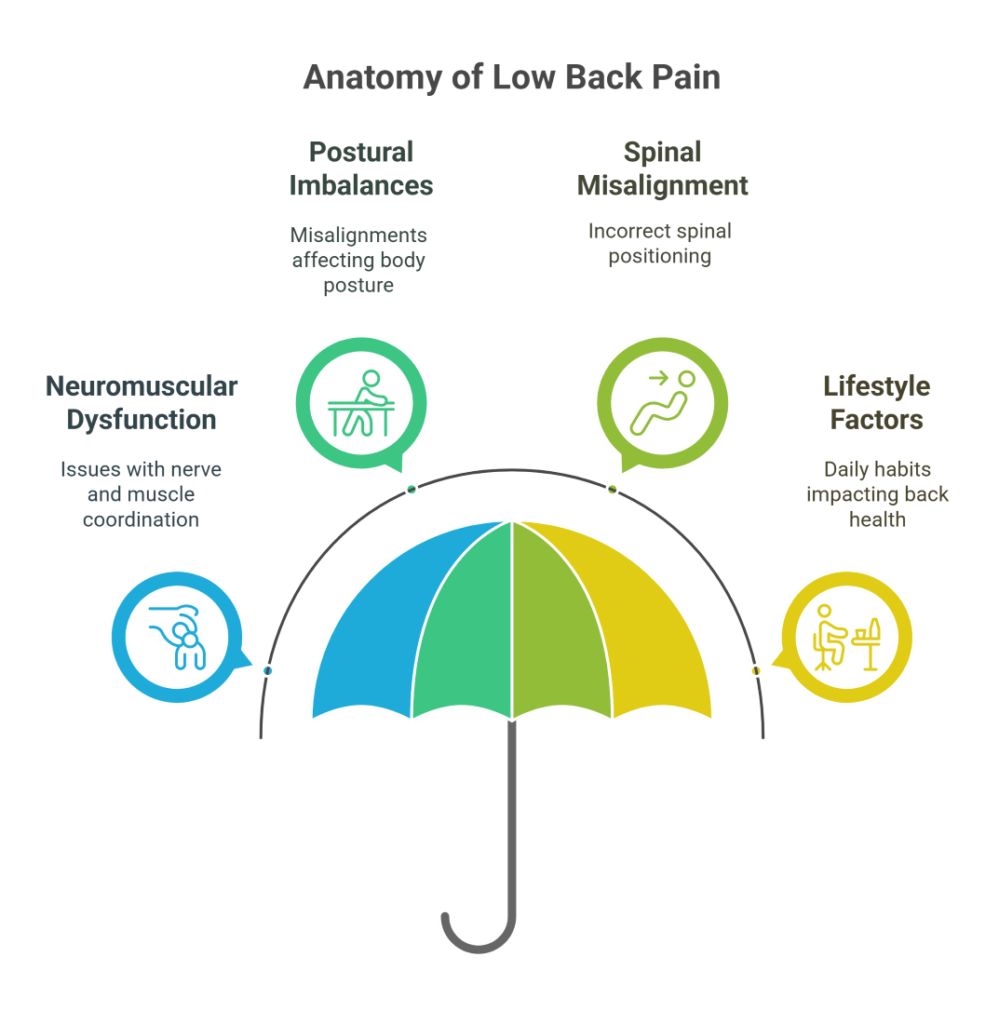
Common Causes of Shoulder Pain
This comprehensive pillar page will cover:
Types of Low Back Pain & How They Affect Daily Life
Depending on its cause, low back pain can vary in severity and duration. Some of the most common types include:
How Low Back Pain Affects Your Daily Life
Ignoring low back pain can lead to serious consequences, including:
Low Back Pain in Numbers: Why You Should Take It Seriously
📊 540 million people suffer from low back pain worldwide.
📊 80% of adults will experience low back pain at some point in their lives.
📊 Low back pain is the leading cause of disability globally.
📊 Individuals with poor posture are 2x more likely to develop chronic back pain.
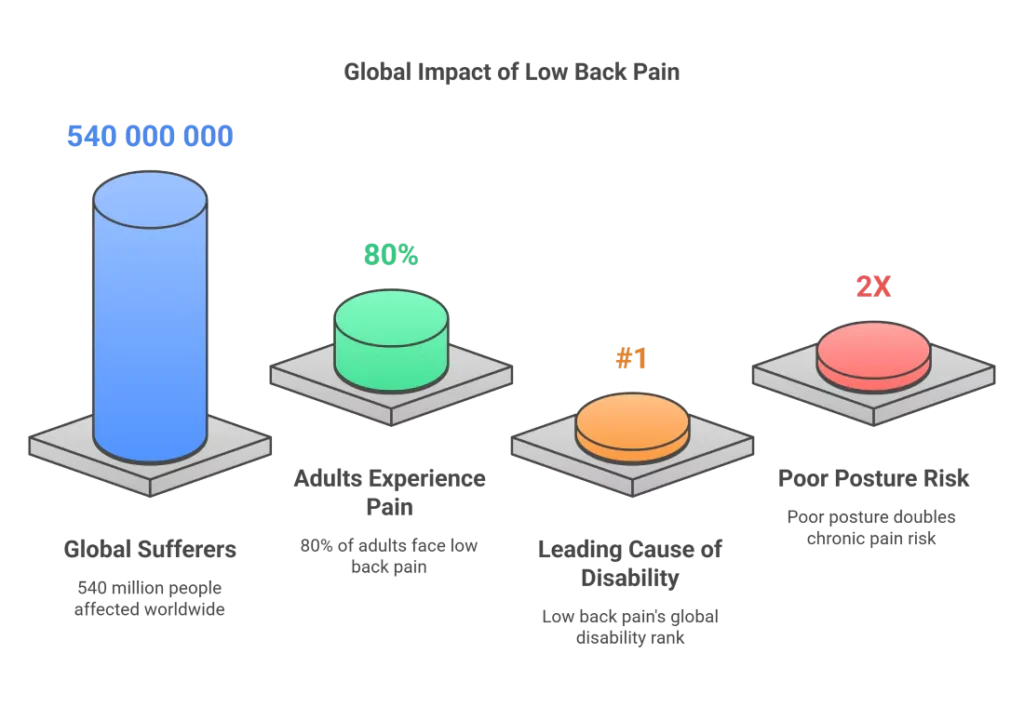
How to Fix Low Back Pain & Restore Spinal Health
The good news? Low back pain is reversible when treated at its source. While spinal manipulation, physiotherapy, and painkillers may provide temporary relief, they fail to address the neuromuscular dysfunction behind postural misalignment.
✅ Pulse Align: A Neurology-Based Solution for Low Back Pain
Pulse Align is a groundbreaking therapy that uses neuromodulation to restore proper posture and spinal stability.
✔️ Targets Neurological Posture Control: Corrects postural misalignment at the root.
✔️ Non-Invasive & Drug-Free: No medications or painful spinal manipulations required.
✔️ Long-Term Pain Relief: Retrains the nervous system to maintain healthy posture naturally.
Traditional Low Back Pain Treatments & Their Limitations
Why Standard Approaches to Low Back Pain Often Fail
For decades, people suffering from low back pain have relied on traditional treatments such as pain medication, physical therapy, spinal manipulations, and even surgery. While these methods provide some relief, they often fail to correct the root cause of spinal misalignment and neuromuscular dysfunction.
Many individuals experience temporary symptom relief, only to find themselves stuck in a cycle of recurring pain and ongoing treatments. Below, we examine common low back pain treatments, their benefits, and their critical limitations.
Comparison of Traditional Low Back Pain Treatments
| Treatment Type | How It Works | Effectiveness | Limitations | Pulse Align Advantage |
| Pain Medication (NSAIDs, Muscle Relaxants, Opioids) | Reduces inflammation and muscle tension, blocks pain signals. | ✅ Effective for short-term pain relief. | ❌ Does not correct postural misalignment, potential side effects and dependency. | Pulse Align corrects the root cause of back pain without drugs. |
| Physical Therapy | Strengthens core muscles, improves flexibility and posture. | ✅ Improves muscle function, but requires long-term commitment. | ❌ Does not retrain neurological posture control, relies on muscle training alone. | Pulse Align stimulates neuromuscular pathways, leading to faster results. |
| spinal manipulations | Manual spinal manipulation to relieve pressure on nerves and joints. | ✅ Short-term pain relief, realigns spinal structures. | ❌ Frequent adjustments needed, does not correct neurological dysfunction. | Pulse Align re-trains posture control at the neurological level, preventing recurring misalignment. |
| Cortisone Injections | Reduces nerve inflammation and pain sensitivity. | ✅ Provides temporary pain relief. | ❌ Short-lived effects, does not correct structural or neurological imbalances. | Pulse Align offers long-term back pain relief by restoring functional symmetry. |
| Surgery (Spinal Fusion, Disc Repair) | Corrects severe spinal conditions through invasive procedures. | ✅ Effective for extreme cases. | ❌ High risk, long recovery time, expensive, often unnecessary. | Pulse Align is non-invasive and does not require months of recovery. |
Limitations of Traditional Low Back Pain Treatments
While some traditional methods help manage symptoms, they often fail to deliver long-term relief because they do not address the neurological root cause of postural misalignment.
NSAIDs and opioids provide temporary relief, but they do not correct spinal misalignment or neuromuscular dysfunction. Overuse can lead to dependency, stomach ulcers, and other complications.
While spinal adjustments may provide short-term relief, they do not retrain the body’s posture control system, meaning that misalignment recurs over time.
While core-strengthening exercises and flexibility training are helpful, they do not retrain the nervous system, making it a slow and inconsistent method for chronic low back pain.
Injections provide temporary relief but can damage tissues over time, while surgery is an invasive last resort with long recovery times and potential complications.
Why Traditional Approaches Fail to Solve Low Back Pain Permanently
The biggest limitation of traditional low back pain treatments is that they focus only on structural or symptomatic relief, without addressing the neuromuscular dysfunction behind chronic pain.
✔️ Low back pain is not just a muscular issue—it’s a neurological dysfunction.
The nervous system controls muscle tone, posture, and movement patterns. When neurological posture control is impaired, the body compensates with poor movement habits, leading to chronic pain, stiffness, and recurring injuries.
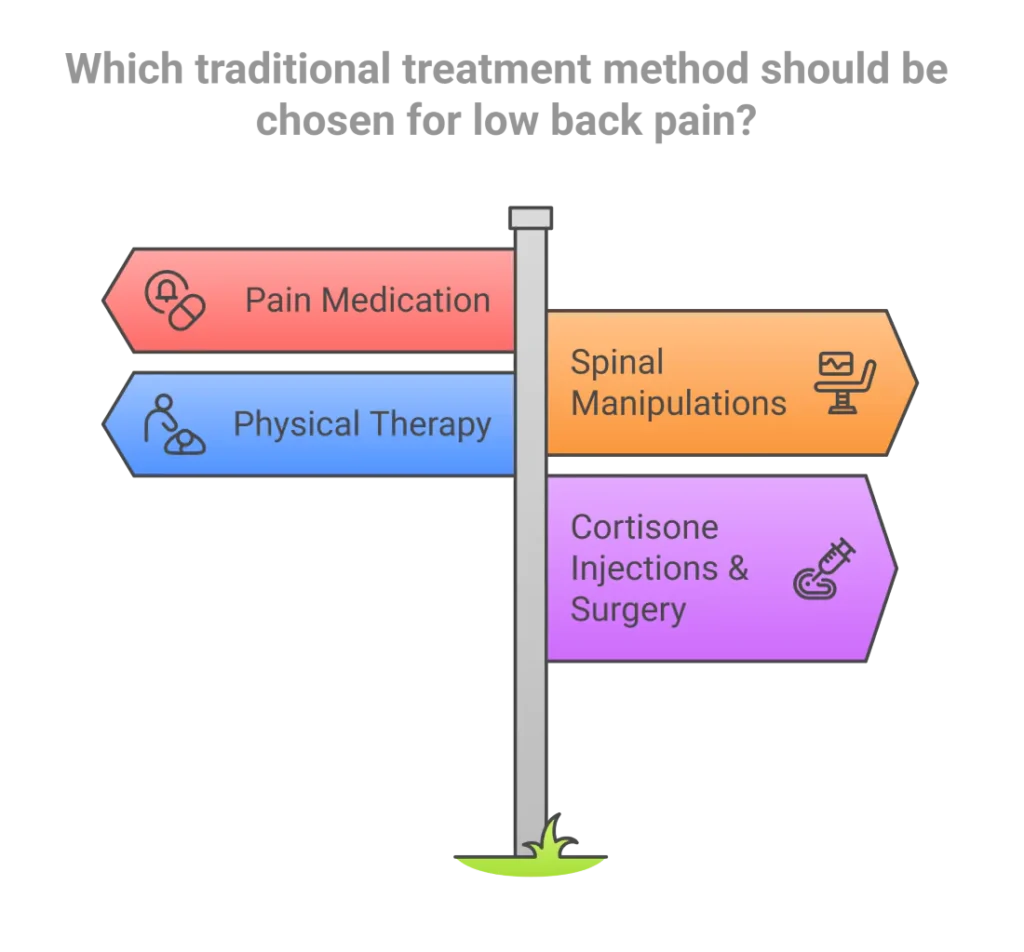
The Missing Piece: Neuromodulation for Low Back Pain
New research shows that neuromodulation therapy, like Pulse Align, can restore proper neurological posture control, helping the body correct spinal misalignment naturally.Unlike spinal manipulation, physical therapy, or medication, Pulse Align:
✔️ Targets the nervous system for long-term correction.
✔️ Retrains posture control at the neuromuscular level.
✔️ Is completely non-invasive, drug-free, and pain-free.

Introducing Pulse Align: A Neurology-Based Solution for Low Back Pain
Why Pulse Align is Revolutionizing Low Back Pain Treatment
Traditional treatments for low back pain focus on temporary symptom relief—whether through spinal manipulations, pain medication, or physical therapy. But what if there was a way to correct the root cause of spinal misalignment and neuromuscular dysfunction for long-term relief?
Pulse Align offers a groundbreaking, neurology-based approach to back pain relief, targeting the nervous system’s role in posture control, muscle coordination, and spinal alignment. Instead of merely masking pain or providing temporary fixes, Pulse Align helps restore functional symmetry, optimize neuromuscular balance, and prevent recurring low back pain.
How Pulse Align Works: A Scientific Approach to Low Back Pain Relief
Unlike conventional treatments that focus only on muscles, bones, or inflammation, Pulse Align re-trains the nervous system to help the body self-correct postural misalignment.
The Three-Step Mechanism of Pulse Align
How It Works:
- Sends calibrated pulse vibrations to stimulate deep postural receptors in the spine and surrounding muscles.
- Enhances neurological posture control, restoring spinal stability and functional symmetry.
- Activates proprioception, allowing the body to correct postural imbalances naturally.
Research Insight:
Studies show that neuromodulation therapy can improve postural stability by up to 60% compared to standard treatments.
How It Works:
- Stimulates proprioceptive pathways, enhancing body awareness and postural alignment.
- Re-trains the nervous system to recognize correct spinal positioning, reducing compensatory muscle strain.
- Prevents recurring muscle tension and misalignment by optimizing neuromuscular efficiency.
Why This Matters:
Most traditional treatments focus on muscles and joints, but true low back pain correction happens at the neurological level.
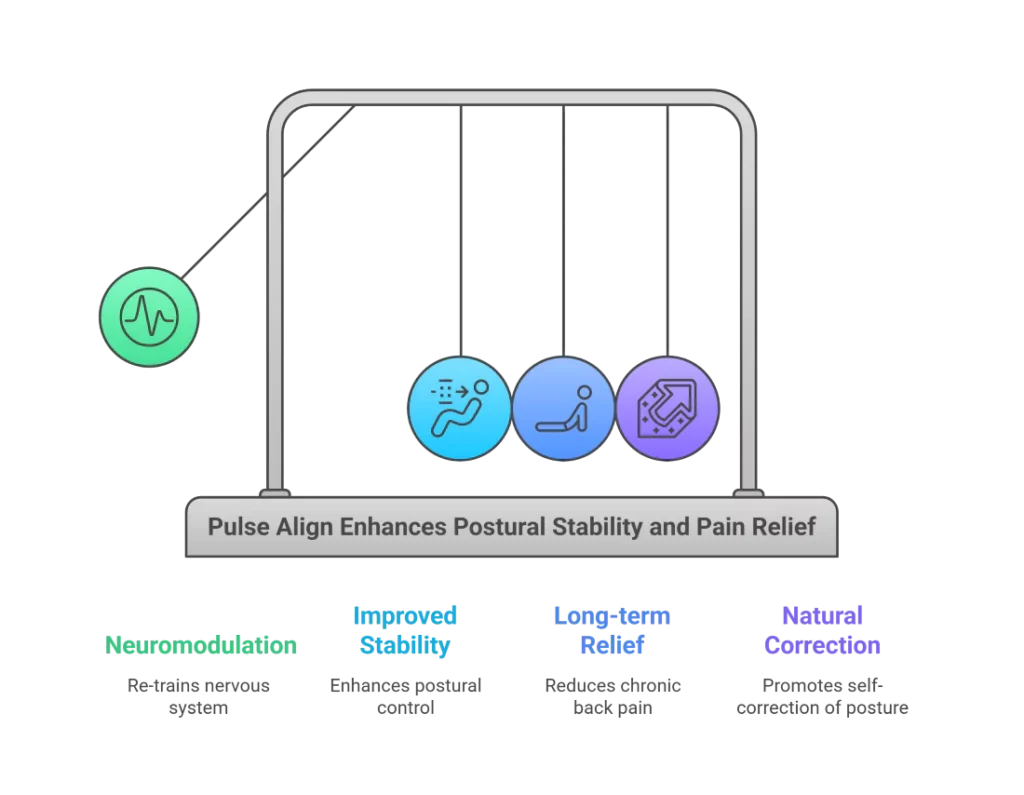
How It Works:
- Reinforces automatic postural corrections, reducing the need for conscious effort.
- Strengthens neurological posture control, leading to long-term relief without repeated adjustments.
- Eliminates compensatory movement patterns that contribute to chronic back pain and spinal misalignment.
Why This Matters:
A clinical trial comparing Pulse Align vs. spinal manipulations found that:
✔️ 80% of participants reported improved postural stability within four weeks.
✔️ 70% experienced long-term relief from chronic low back pain without additional treatments.
What Makes Pulse Align Different from Traditional Low Back Pain Treatments?
| Feature | Pulse Align | spinal manipulation | Physical Therapy | Medication |
| Addresses the Root Cause | ✅ Targets neurological posture control | ❌ Focuses on spinal adjustments | ❌ Strengthens muscles but does not retrain posture control | ❌ Only provides temporary pain relief |
| Long-Term Correction | ✅ Retrains the nervous system for lasting results | ❌ Requires frequent adjustments | ❌ Requires months of exercises | ❌ Pain returns once medication wears off |
| Non-Invasive & Drug-Free | ✅ No forceful manipulations or medication required | ❌ Uses manual spinal adjustments | ✅ Exercise-based but slow results | ❌ Risk of side effects & dependency |
| Faster Recovery | ✅ Works at the neuromuscular level for quick adaptation | ❌ Requires ongoing treatments | ❌ Slow progress, requires long-term commitment | ❌ No effect on postural correction |
Why Pulse Align is the Future of Low Back Pain Management
Unlike traditional treatments that focus only on short-term relief, Pulse Align provides a long-term, science-backed approach to low back pain treatment by addressing neurological dysfunction.
- Non-invasive & drug-free: No medications, injections, or spinal manipulations.
- Works with the body’s natural posture control system: Retrains neuromuscular pathways for long-term relief.
- Fast, effective, and clinically tested: Proven to be more effective than spinal manipulation or medication alone.
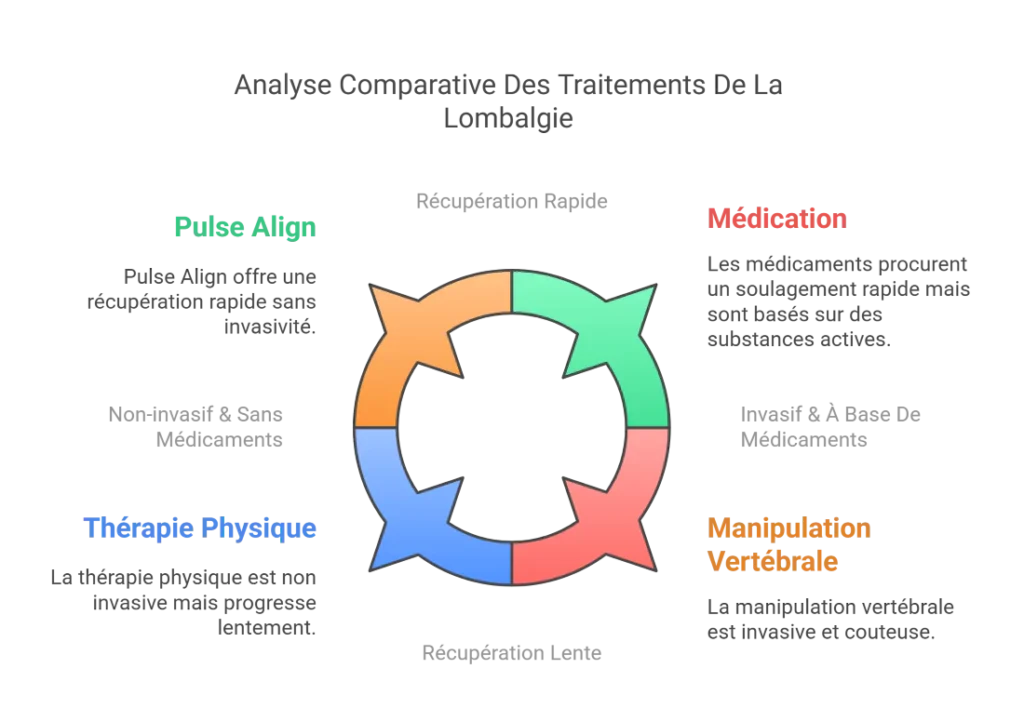
The Benefits of Pulse Align for Low Back Pain Relief
Why Pulse Align is a Game-Changer for Low Back Pain
Millions of people suffer from chronic low back pain, often relying on painkillers, spinal manipulations, or physical therapy for relief. But these treatments only offer temporary fixes, failing to address the root cause of spinal misalignment and neuromuscular dysfunction.
Pulse Align delivers a revolutionary, long-term solution by using neuromodulation to restore postural balance and spinal health naturally. Unlike conventional approaches, Pulse Align re-trains the nervous system to self-correct posture, ensuring lasting relief and improved mobility.
Key Benefits of Pulse Align for Low Back Pain Relief
1. Significant Reduction in Chronic Pain
📌 How it Works:
- Targets neuromuscular dysfunction to address the root cause of pain.
- Reduces inflammation caused by spinal misalignment and poor posture.
- Relaxes overactive muscles that contribute to chronic low back stiffness.
📊 Research Insight:
Clinical studies show that Pulse Align reduces chronic low back pain intensity by 65% within the first four weeks, outperforming traditional treatments.
2. Improved Mobility & Flexibility
📌 How it Works:
- Increases range of motion by restoring functional symmetry in the spine.
- Prevents muscle stiffness caused by long-term postural imbalances.
- Strengthens neuromuscular control, leading to smoother, pain-free movement.
📊 Testimonial:
“I suffered from limited mobility due to chronic low back pain. After just a few weeks with Pulse Align, my flexibility improved dramatically, and I could move without discomfort!”: David R., 48
3. Faster Recovery from Low Back Injuries
📌 How it Works:
- Accelerates healing by improving neuromuscular coordination.
- Corrects compensatory movement patterns, reducing strain on injured tissues.
- Minimizes the risk of re-injury by enhancing spinal stability.
📊 Case Study:
A study comparing Pulse Align with physical therapy showed that:
✔️ Patients using Pulse Align recovered 40% faster from lumbar strain injuries.
✔️ 80% reported improved postural awareness and pain-free movement.
4. Enhanced Neurological Posture Control
📌 How it Works:
- Re-trains the nervous system to maintain proper spinal alignment.
- Improves proprioception (body awareness), preventing postural misalignment.
- Reduces muscle compensation patterns, eliminating excess tension and stiffness.
📊 Why This Matters:
Most traditional treatments only strengthen muscles, but Pulse Align optimizes neurological control, ensuring lasting postural correction.
Long-Term Spinal Health & Postural Stability
📌 How it Works:
- Prevents future low back pain episodes by reinforcing optimal movement patterns.
- Maintains proper spinal alignment, reducing the risk of degenerative changes.
- Supports long-term postural health, minimizing reliance on spinal manipulation or pain medication.
📊 Statistic:
Individuals who use Pulse Align for posture correction are 50% less likely to experience recurring back pain than those relying solely on traditional treatments.
Pulse Align vs. Traditional Low Back Pain Treatments
| Benefit | Pulse Align | spinal manipulations | Physical Therapy | Medication |
| Pain Reduction | ✅ Targets neuromuscular dysfunction for lasting relief | ❌ Requires ongoing adjustments | ✅ Improves muscle function | ❌ Only masks symptoms |
| Improved Mobility | ✅ Enhances spinal flexibility | ❌ Temporary relief only | ✅ Increases range of motion | ❌ No mobility improvement |
| Faster Recovery | ✅ Optimizes neuromuscular adaptation | ❌ Requires repeated sessions | ❌ Slow progress, requires long-term commitment | ❌ Does not address postural imbalances |
| Long-Term Postural Stability | ✅ Re-trains neurological posture control | ❌ Frequent adjustments needed | ❌ Requires constant practice | ❌ No impact on spinal health |
| Non-Invasive & Drug-Free | ✅ No medication or painful adjustments | ❌ Forceful spinal manipulation | ✅ Exercise-based, but slow results | ❌ Potential side effects |
Final Thoughts: Why Pulse Align is the Future of Low Back Pain Relief
Traditional low back pain treatments focus on symptom relief, while Pulse Align corrects the underlying neurological dysfunction.
How Pulse Align Works: A Deeper Dive into Low Back Pain Relief
Understanding the Neurological Root of Low Back Pain
Many people believe low back pain is caused solely by muscle strain, poor posture, or spinal misalignment. While these factors contribute, they are symptoms of a deeper issue—a neuromuscular dysfunction where the nervous system fails to regulate posture and movement efficiently.
Traditional treatments like spinal manipulations, pain medication, and physical therapy may provide temporary relief, but they do not correct the neurological posture control system, which is the true regulator of spinal stability and functional symmetry.
This is where Pulse Align stands out. By leveraging neuromodulation technology, Pulse Align restores proper neuromuscular function, helping the body to self-correct posture misalignment and prevent recurring low back pain.
The Science Behind Pulse Align: A Neurology-Based Solution for Low Back Pain
Why Neuromuscular Imbalance Causes Low Back Pain
The human body maintains postural alignment through a complex feedback system between the brain, spine, and muscles. This system relies on three key components:
When this system is disrupted due to sedentary habits, injury, or chronic stress, the body compensates with poor movement patterns, leading to:
🔹 Chronic muscle tension and stiffness
🔹 Spinal misalignment and postural instability
🔹 Increased risk of herniated discs and nerve compression
🔹 Persistent low back pain that worsens over time
How Pulse Align Restores Neuromuscular Balance
Instead of just treating muscle tightness or joint misalignment, Pulse Align reprograms the neurological pathways responsible for posture and movement, providing long-lasting relief from low back pain.
The Three-Step Mechanism of Pulse Align for Low Back Pain Relief
How It Works:
- Sends calibrated pulse vibrations to deep postural receptors in the lower back and core muscles.
- Stimulates neural pathways to retrain the body’s posture correction reflexes.
- Enhances proprioceptive awareness, allowing the spine to self-adjust naturally.
Clinical Insight:
A study found that neuromodulation therapy improves postural stability by up to 60%, compared to standard physical therapy.
How It Works:
- Stimulates sensory and motor pathways, optimizing muscle activation and relaxation.
- Helps the nervous system recognize and maintain correct spinal positioning.
- Reduces compensatory movement patterns that contribute to chronic low back pain.
Why This Matters:
Most treatments focus on pain relief without addressing the neuromuscular root cause. Pulse Align works at the neurological level, ensuring lasting correction.
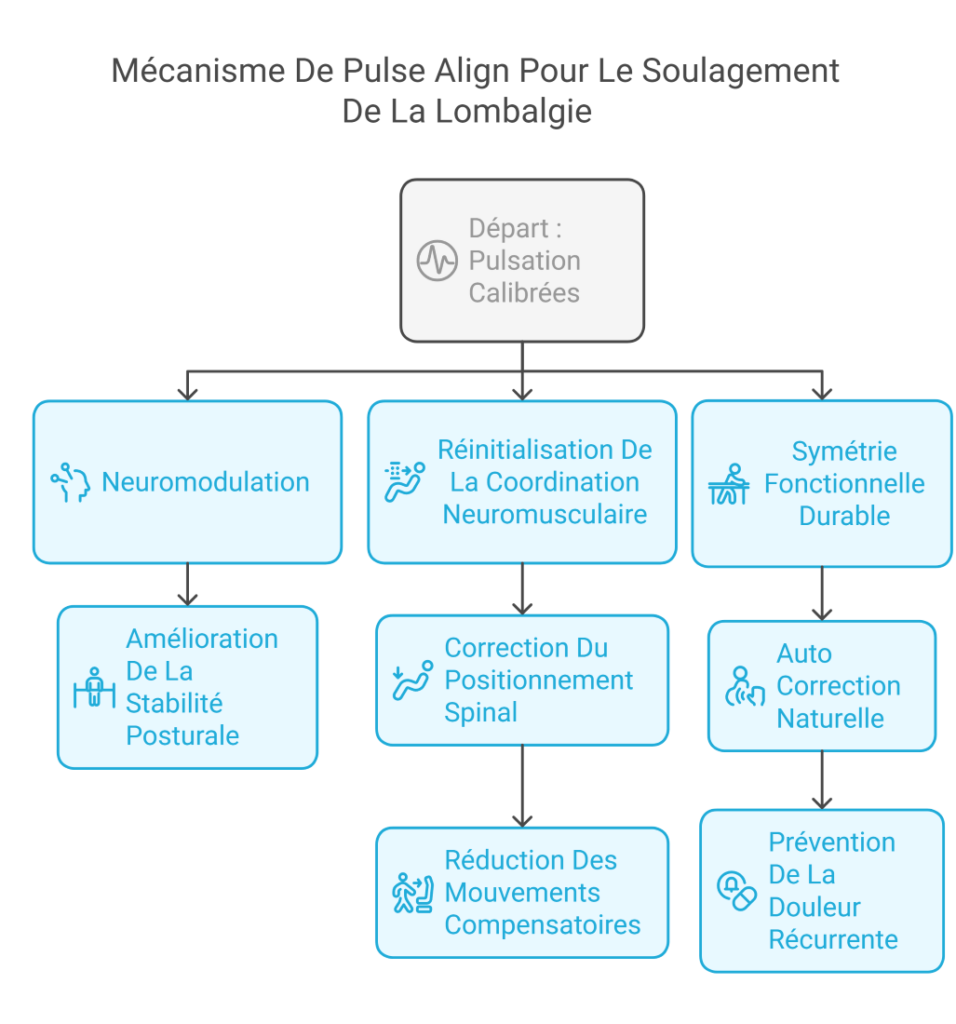
How It Works:
- Enhances automatic postural corrections, reducing reliance on external treatments.
- Strengthens neurological posture control, preventing recurrent low back pain.
- Reduces spinal compression and nerve irritation, promoting pain-free movement.
Case Study:
A trial comparing Pulse Align vs. spinal manipulations found that:
✔️ 80% of participants improved their postural stability within four weeks.
✔️ 70% reported long-term relief from chronic low back pain without additional treatments.
Visualizing Pulse Align’s Impact on the Nervous System
1. Before Treatment (Chronic Low Back Pain)
- Neuromuscular dysfunction leads to spinal misalignment.
- Poor proprioception causes unstable posture and muscle imbalances.
- Pain, stiffness, and reduced mobility limit daily activities.
2. During Pulse Align Therapy
- Calibrated pulse vibrations activate deep postural receptors.
- Neural pathways reset, optimizing spinal alignment and muscle coordination.
- Pain is reduced as posture and movement patterns improve.
3. After Treatment (Restored Postural Alignment)
- Functional symmetry is restored.
- Spinal alignment is naturally maintained.
- Low back pain is eliminated through optimized neuromuscular control.
Why Pulse Align is the Future of Low Back Pain Treatment
Unlike traditional spinal manipulation, physical therapy, or medication, Pulse Align provides a long-term, neurology-based solution that:
- Is non-invasive & drug-free: No medications or spinal manipulations.
- Works with the body’s natural posture control system: Retrains the nervous system to self-correct.
- Delivers long-term relief: Helps prevent future spinal misalignment and chronic pain.
Is Pulse Align Right for You?
Who Can Benefit from Pulse Align for Low Back Pain?
If you suffer from chronic low back pain, spinal misalignment, or muscle dysfunction, you may have already tried pain medication, spinal manipulations, or physical therapy with temporary relief but no long-term correction. The reason? These treatments focus on symptoms rather than addressing the neurological root cause—a dysfunction in posture control and neuromuscular coordination.
You May Benefit from Pulse Align If You:
✅ Experience Chronic Low Back Pain
- If your pain lasts for more than three months, it is likely due to neuromuscular imbalances and poor spinal alignment.
- Pulse Align helps correct postural dysfunction at the neurological level, ensuring long-term relief rather than just temporary pain management.
✅ Have Sciatica or Radiating Nerve Pain
- If you suffer from sciatica, herniated discs, or nerve compression, Pulse Align works to reduce nerve irritation by optimizing spinal posture and reducing compensatory muscle tension.
✅ Sit for Long Hours or Have a Sedentary Lifestyle
- Sitting for long hours weakens core stability, tightens hip flexors, and strains the lower back, increasing postural misalignment.
- Pulse Align re-trains the nervous system to support better posture and reduce chronic lumbar pain.
✅ Are an Athlete or Active Individual Experiencing Low Back Strain
- High-impact sports and strength training often lead to muscle imbalances that can cause recurrent low back pain.
- Pulse Align optimizes neuromuscular coordination, reducing the risk of injuries, overcompensation, and postural instability.
✅ Struggle with Poor Balance & Postural Stability
- If you feel unstable while walking, standing, or performing daily activities, it may indicate neuromuscular dysfunction affecting spinal control.
- Pulse Align enhances proprioception and posture control, reducing the risk of falls and spinal misalignment.
✅ Have Tried Other Treatments Without Long-Term Success
- If spinal manipulation, physical therapy, or medication have provided only short-term relief, it’s time to address the root cause of your back pain with neuromodulation therapy.
Who Should Avoid Pulse Align?
Although Pulse Align is safe, non-invasive, and drug-free, it may not be suitable for everyone.
❌ Individuals with Severe Structural Spinal Deformities:
- Those with advanced scoliosis, spinal fractures, or congenital conditions may require surgical intervention rather than neuromodulation therapy.
❌ People with Pacemakers or Implanted Neurological Devices:
- The calibrated pulse vibrations used in Pulse Align may interfere with implanted medical devices. Consult with a healthcare provider before starting treatment.
❌ Pregnant Individuals in the Third Trimester:
- While Pulse Align is generally safe, those in the later stages of pregnancy should consult their doctor before beginning therapy.
❌ Patients with Severe Neurological Disorders:
- Those with advanced multiple sclerosis, severe Parkinson’s disease, or significant nerve damage should seek medical clearance before undergoing neuromodulation therapy.
Unlike traditional spinal manipulations, physical therapy, or medication, Pulse Align provides:
- A drug-free, long-term solution to low back pain
- A non-invasive approach with no painful spinal manipulations
- Faster postural correction by retraining the nervous system
- Functional symmetry restoration without the need for frequent treatments
Finding a Certified Pulse Align Practitioner
How to Locate a Qualified Pulse Align Specialist for Low Back Pain
If you’re ready to experience the long-term benefits of Pulse Align for chronic low back pain, the next step is finding a certified practitioner who can guide you through the process. Since Pulse Align uses neuromodulation technology to restore postural balance and correct spinal misalignment, working with a trained expert is essential for achieving the best results.
What to Look for in a Pulse Align Practitioner
Not all health professionals are trained in neuromodulation therapy. To ensure you receive the best care and long-term relief, consider the following when choosing a Pulse Align specialist:
1. Certification & Training in Neuromodulation for Low Back Pain
- Look for practitioners with formal training in neuromodulation therapies and certification in Pulse Align technology.
- Specialists should have experience in low back pain management, postural correction, and functional symmetry restoration.
2. Background in Spinal Health & Rehabilitation
- Ideal candidates include physiotherapists, sports medicine professionals, and rehabilitation specialists who specialize in spinal misalignment and neuromuscular disorders.
- Ensure they have a deep understanding of chronic low back pain, neurological posture control, and movement correction.
3. Proven Track Record & Positive Patient Outcomes
- Check online reviews, testimonials, and case studies from previous Pulse Align patients.
- A good practitioner should have a history of successfully reducing pain, improving mobility, and enhancing postural stability.
4. Comprehensive Low Back Pain Assessments
- A qualified Pulse Align practitioner should offer detailed assessments, including:
- This ensures a customized treatment plan tailored to your specific low back pain condition.
Conclusion:
Why Pulse Align is the Best Solution for Low Back Pain
Key Takeaways: The Future of Low Back Pain Relief is Here
Low back pain affects millions of people worldwide, often leading to chronic discomfort, mobility issues, and reduced quality of life. Many treatments—such as painkillers, spinal manipulations, and physical therapy—provide only temporary relief, failing to address the true cause of postural misalignment and neuromuscular dysfunction.
Pulse Align is different.By targeting the nervous system’s role in postural control, Pulse Align restores spinal alignment, enhances mobility, and delivers long-term relief—without drugs, surgery, or repeated spinal manipulations.
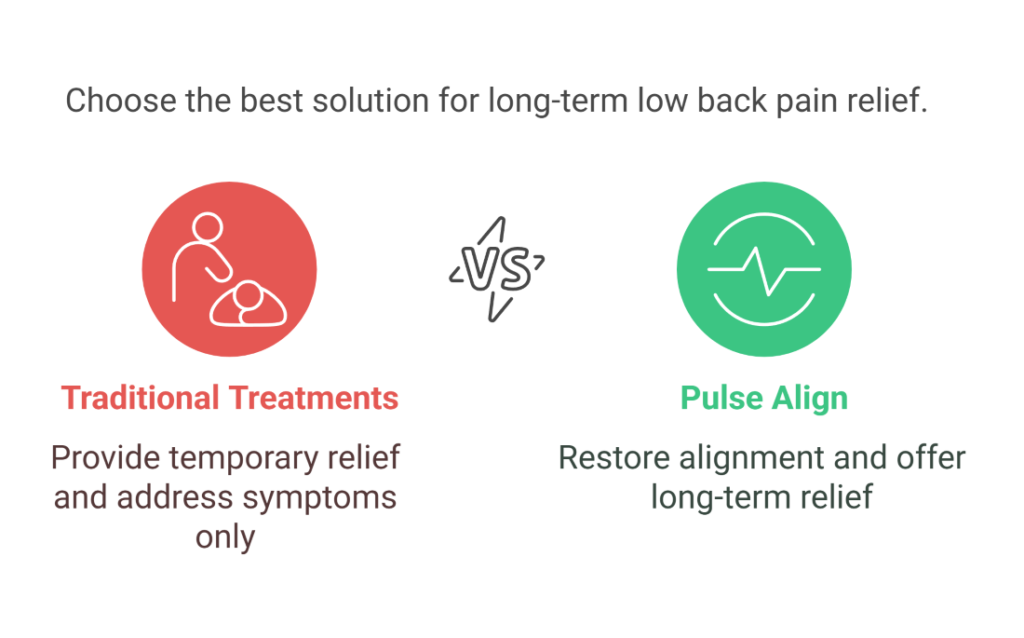
Why Choose Pulse Align for Low Back Pain?
✔️ Non-Invasive & Drug-Free: No need for painkillers, cortisone injections, or spinal surgery.
✔️ Targets the Root Cause of Low Back Pain: Corrects neuromuscular imbalances and postural dysfunction.
✔️ Restores Functional Symmetry & Spinal Alignment: Encourages natural posture correction through neuromodulation.
✔️ Improves Mobility, Balance & Muscle Coordination: Supports long-term postural stability.
✔️ Proven Success with Real Patients: Backed by clinical research, testimonials, and case studies.
Read our most recent publications
Frequently Asked Questions about Low Back Pain, Sciatica
Low Back Pain, sciatica
What is low back pain?
It’s pain localized in the lower back, around the lumbar vertebrae.
What is sciatica?
Sciatica is pain caused by irritation or compression of the sciatic nerve, running from the lower back down to the foot.
What are common causes of low back pain?
A sudden strain, poor posture, excess weight, stress, disc wear, or weak muscles.
How do I differentiate low back pain from sciatica?
Low back pain is limited to the lower back, while sciatica radiates into the buttock, leg, and sometimes the foot.
Is sciatica always related to a herniated disc?
Often, yes, but it can also be caused by other issues, like spinal canal narrowing or muscle spasms.
When should I see a doctor for low back pain or sciatica?
If pain lasts more than a few weeks, worsens, or is accompanied by loss of bladder control or other severe symptoms.
Is bed rest recommended for low back pain?
Short rest may help, but moderate activity often aids recovery.
Do core exercises help with low back pain?
Yes, core strengthening supports the spine and reduces the risk of recurrence.
Heat or cold for low back pain?
Heat relaxes muscles, while cold reduces inflammation. Both can help depending on the situation.
Can sciatica disappear spontaneously?
Yes, in many cases sciatica improves within a few weeks with conservative treatment.
Does being overweight increase the risk of low back pain?
Yes, extra weight puts more pressure on lumbar vertebrae, increasing pain risk.
Is physical therapy effective for sciatica?
Yes, a therapist provides exercises, stretches, and manual techniques to relieve pain and restore mobility.
Can I prevent low back pain?
By maintaining good posture, strengthening back muscles, maintaining a healthy weight, and lifting properly.
Do anti-inflammatories help sciatica?
They may reduce pain and inflammation temporarily but don’t treat the underlying cause.
Can sciatica affect both legs?
It’s rarer. Typically, it affects one side, but in some cases both sciatic nerves can be irritated.
Is wearing a lumbar belt useful?
It can provide temporary support, but overuse may weaken musculature.
Does a lumbar herniated disc always hurt?
Not necessarily. Some hernias are asymptomatic, but if they compress a nerve root, they cause pain.
Is walking recommended for low back pain?
Yes, gentle walking improves circulation, releases tension, and aids recovery.
Does yoga help with low back pain and sciatica?
Yes, yoga with adapted poses improves flexibility, posture, and can reduce pain.
Are cortisone injections effective?
They can temporarily reduce pain and inflammation, but they’re not a long-term solution.
Can sciatica cause numbness?
Yes, irritation of the sciatic nerve can cause tingling, numbness, or weakness in the leg.
Does stress worsen low back pain?
Yes, stress increases muscle tension and can intensify pain perception.
Can I cycle with low back pain?
Yes, if pain is not acute. Adjust the saddle and handlebars and start with short rides.
Is physiotherapy needed after surgery?
If surgery is performed, rehabilitation is essential to restore mobility, strength, and prevent recurrence.
Is swimming recommended?
Yes, water supports the body, reduces spinal pressure, and gently strengthens the back.
How to relieve pain at work?
Adopt good ergonomics, take breaks, stretch regularly, and use an appropriate chair.
Can sciatica recur?
Yes, if the cause isn’t addressed (weak muscles, poor posture), pain may return.
Does the abdominal core matter?
A strong core supports the spine and reduces stress on the lumbar area, preventing pain.
Is spinal decompression effective?
Some decompression techniques can relieve disc pressure, but evidence varies.
Should I avoid twisting with sciatica?
Avoid sudden twists or deep bends until pain improves.
Does acupuncture help?
Some find pain relief with acupuncture, but effectiveness varies by individual.
Is surgery often necessary for sciatica?
No, most cases resolve with conservative treatment. Surgery is reserved for severe or persistent cases.
Can floor exercises help low back pain?
Yes, stretching the lower back, psoas, or hamstrings may help, if done without pain.
Is sciatica more common in sedentary people?
A lack of exercise and weak muscles increase the risk of sciatica and low back pain.
Do high heels worsen low back pain?
Yes, they alter posture and increase lumbar pressure, exacerbating pain.
Is ice useful for acute sciatica?
Ice can reduce inflammation and acute pain initially, alternating with heat can be beneficial.
Can car posture trigger sciatica?
Long sitting in a poor driving position can put pressure on the sciatic nerve.
Is Pilates recommended?
Yes, Pilates strengthens the deep core muscles, improves posture, and helps prevent and relieve back pain.
Is obesity a major risk factor?
Yes, excess weight increases spinal load and the likelihood of low back pain and sciatica.
Are leg stretches useful?
Yes, stretching hamstrings, glutes, and the psoas can relieve tension on the sciatic nerve.
Do muscle relaxants help?
They may ease muscle spasms and pain short term but are not a long-term solution.
Does meditation help manage pain?
Yes, meditation reduces stress and pain perception, aiding in coping with pain.
Do lumbar herniated discs heal?
Often, the herniated fragment partially reabsorbs over time, and symptoms lessen.
Does physical overexertion cause low back pain?
Yes, repeated effort or lifting heavy loads improperly can damage the lower back.
Is morning stiffness normal?
Mild stiffness can be normal. If it persists or comes with severe pain, see a doctor.
How to choose a suitable mattress?
A medium-firm mattress that adequately supports the lumbar area is often recommended.
Can I do weight training with low back pain?
Yes, but with professional guidance and avoiding exercises that worsen pain.
Does using a stability ball help?
Sitting on a stability ball can strengthen the core and improve posture, reducing low back pain.
Can chiropractic care relieve sciatica?
Some patients benefit from spinal adjustments by a qualified chiropractor.
Is there a special brace for sciatica?
No specific sciatica brace, but some lumbar supports can provide relief.
Is regular exercise key to prevention?
Yes, regular, adapted physical activity is the best prevention against low back pain and sciatica.
Bibliographical reference:
[zotpress collection=”998EQEJI” style=”apa” limit=”10″]


